5 November 2024 : Daily Current Affairs
1. NCST Challenges NTCA’s Village Relocation Advisory, Citing Tribal Rights and Legal Concerns in Tiger Reserves
(Source: Indian Express; Section: Express Network; Page: 07)
| Topic: GS2 – Social Justice |
| Context: |
|
Analysis of News:
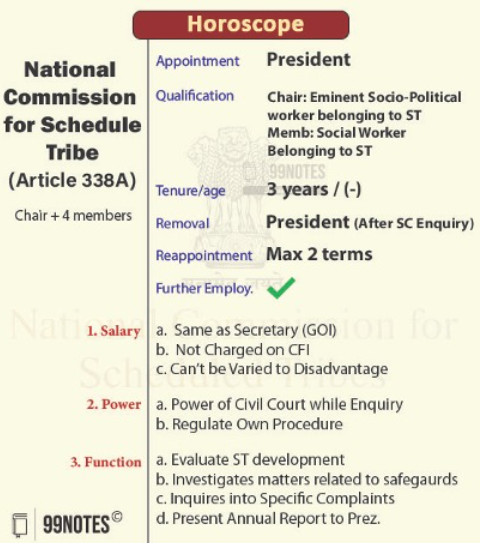
What is the NCST?
- Formation: NCST was set up in 2004 by amending Article 338 and by inserting a new article 338A in the Constitution through the 89th Constitution Amendment Act, 2003. Hence, it is a constitutional body.
- By this amendment, the erstwhile National Commission for Scheduled Castes and Scheduled Tribes was replaced by two separate Commissions namely:
- the National Commission for Scheduled Castes (NCSC), and
- the NCST
- Objective: Article 338A inter-alia gives powers to the NCST to oversee the implementation of various safeguards provided to Scheduled Tribes (STs) under the Constitution or under any other law for time being in force or under any other order to the Government and to evaluate the working of such safeguards.
- Composition: It consists of a Chairperson, a Vice-Chairperson and 3 other Members who are appointed by the President by warrant under his hand and seal.
- At least one member should be a woman.
- The Chairperson, the Vice-Chairperson and the other Members hold office for a term of 3 years.
- The Chairperson has been given the rank of Union Cabinet Minister, the Vice Chairperson has the rank of a Minister of State and other Members have the rank of Secretary to the Government of India.
- The members are not eligible for appointments for more than two terms.
NCST Seeks Clarifications and Reports
- Following a full commission meeting, the NCST decided to request a report from NTCA on the village relocation issue, officially ratifying this decision in October.
- The commission is also asking for an action-taken report from both NTCA and the Union Environment Ministry regarding NCST’s previous recommendations for better compensation under the Land Acquisition, Rehabilitation, and Resettlement Act, 2013.
Compensation Package and Relocation Concerns
- In 2021, NTCA raised the relocation compensation from Rs 10 lakh to Rs 15 lakh per family.
- However, the NCST seeks further details on NTCA’s response to its 2018 recommendations, which emphasized that compensation should fully align with the 2013 Resettlement Act and offer comprehensive entitlements, including land and infrastructure support.
Legal and Tribal Rights Concerns
- Tribal rights groups argue that the NTCA’s advisory for prioritizing village relocation conflicts with the Forest Rights Act, 2006, and the Wildlife Protection Amendment Act, 2006.
- They assert that relocation must be voluntary, respecting the informed consent of tribal communities as well as the legal recognition of their rights.
- The advisory’s omission of these provisions has sparked concerns that the NTCA’s approach may not fully align with established legal requirements.
Conclusion: Balancing Conservation and Tribal Rights
- The NCST’s intervention highlights a critical need for ensuring that conservation efforts respect the rights of indigenous communities.
- By seeking clarification and a revised compensation framework, NCST aims to balance the preservation of tiger habitats with the rights and welfare of affected tribal populations.
| About National Tiger Conservation Authority (NTCA): |
|
| PYQ: What are the two major legal initiatives by the State since Independence, addressing discrimination against Scheduled Tribes (STs)? (150 words/10m) (UPSC CSE (M) GS-1 2017) |
| Practice Question: Discuss the challenges in balancing wildlife conservation efforts with the rights of tribal communities, with reference to the recent NCST intervention in village relocations from tiger reserves. Suggest measures to ensure both environmental protection and social justice. (250 words/15 m) |
2. SC to consider ‘perpetual ban’ on firecrackers in the national capital
(Source – The Hindu, International Edition – Page No. – 4)
| Topic: GS3 – Environment – Environmental pollution and degradation |
| Context |
|
Supreme Court’s Directive on Firecrackers in Delhi
Call for Perpetual Ban:
- The Supreme Court has urged the Delhi government to consider imposing a “perpetual ban” on the use of firecrackers in the national capital.
- This request comes in light of alarmingly high pollution levels during the Deepavali festival.
Pollution Levels Noted:
- The court highlighted that pollution levels in Delhi have reached an “all-time high,” surpassing those recorded during Deepavali in 2022 and 2023.
- An expert report from the Centre for Science and Environment supports these claims.
Concerns About Implementation:
- Justice A.S. Oka pointed out that the existing ban on firecrackers has been poorly enforced.
- The court expressed its intent to extend the ban beyond Deepavali to other festive occasions, including weddings and elections.
Amendments to Air Pollution Act:
- The Supreme Court raised concerns regarding amendments to the Air Pollution Act that came into effect on April 1, 2024.
- These changes reportedly diminished penal measures, allowing violators to face only monetary penalties.
| Implications of the Supreme Court’s directive |
|
Pros:
Cons:
|
| Practice Question: Discuss the implications of the Supreme Court’s directive on a potential perpetual ban on firecrackers in Delhi. What challenges might the government face in enforcing such a ban? (150 Words /10 marks) |
3. COP29 will launch with looming funding gap
(Source – The Hindu, International Edition – Page No. – 7)
| Topic: GS2 – International Relations |
| Context |
|
COP29 Overview
- Following COP28, COP29 is scheduled to occur in Baku, Azerbaijan – continuing discussions on urgent climate financing needs.
- The summit aims to address the financial gaps that hinder effective climate action and sustainable development.
- Discussions will emphasise innovative funding solutions and international cooperation.
Funding Challenges
- Wealthy nations have hit a limit on their willingness to contribute to global conservation efforts, complicating the mobilisation of the targeted $200 billion annually by 2030.
- Only $30 billion is expected from developed countries, despite commitments made during the Kunming-Montreal Global Biodiversity Framework agreement.
- At COP16, nations collectively pledged merely $163 million to the Global Biodiversity Framework Fund, resulting in total contributions of around $400 million, significantly short of the $30 billion target.
- There has been a decline in foreign aid budgets, with development funding for nature conservation dropping from $4.6 billion in 2015 to $3.8 billion in 2022, as reported by the OECD.
- Countries are increasingly looking towards private funding sources to fill the financing gap.
| Practice Question: Discuss the funding challenges for global biodiversity conservation highlighted during COP16. Analyse the implications of inadequate financial commitments from wealthy nations on future climate summits. (150 Words /10 marks) |
4. India’s Green Leap: A Shift from Fossil Fuels to Clean Energy
(Source – https://pib.gov.in/PressNoteDetails.aspx?NoteId=153385&ModuleId=3®=3&lang=1 )
| Topic: GS3 – Indian Economy – Infrastructure – Energy |
| Context |
|
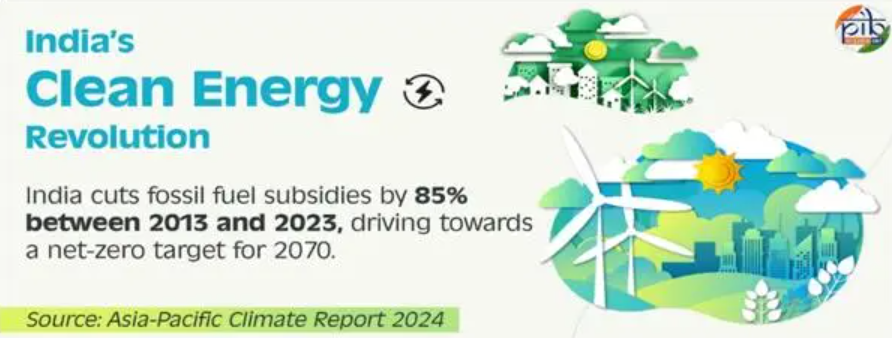
Introduction
- India is making significant strides toward a sustainable energy future amidst a global dependence on fossil fuels.
- With a bold net-zero target set for 2070, India is reimagining its energy strategy.
- The Asian Development Bank’s Asia-Pacific Climate Report highlights India’s shift from fossil fuel subsidies to clean energy investments.
| Asia-Pacific Climate Report |
|
Shift from Fossil Fuels
- India has adopted a “remove, target, and shift” strategy to reduce its reliance on fossil fuels.
- This approach has led to a dramatic reduction in fossil fuel support, paving the way for investments in solar power, electric vehicles, and an enhanced energy grid.
- Between 2014 and 2018, India successfully slashed fossil fuel subsidies, demonstrating a commitment to transforming its energy landscape.
Implementation of Reforms
- The transition was not achieved overnight but through careful and strategic steps.
- The gradual phasing out of petrol and diesel subsidies occurred from 2010 to 2014, followed by tax increases on these fuels until 2017.
- These reforms were designed to create fiscal space for renewable projects, enabling substantial funding for clean energy initiatives.
Fiscal Achievements
- India reduced its fiscal subsidies in the oil and gas sector by an impressive 85%, from a peak of $25 billion in 2013 to $3.5 billion by 2023.
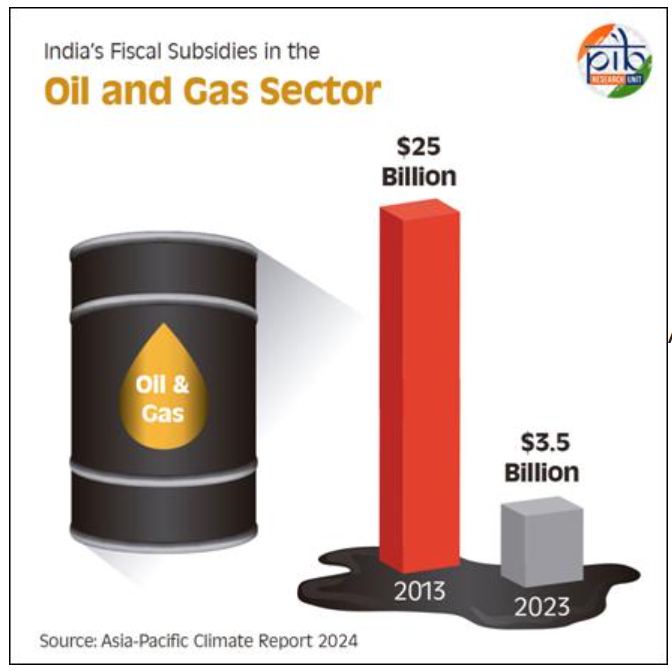
- The government redirected the savings from subsidy reductions into renewable energy projects and infrastructure.
- Increased excise duties on petrol and diesel during periods of low global oil prices generated additional revenue, which was used for targeted subsidies to expand access to liquefied petroleum gas (LPG) for rural communities.
Role of Taxation
- Between 2010 and 2017, the Government of India introduced a cess on coal production and imports, which played a crucial role in financing clean energy initiatives.
- Approximately 30% of the collections from this cess were allocated to a national clean energy and environment fund to support various clean energy projects and research.
- The cess significantly bolstered the budget of the Ministry of New and Renewable Energy, funding programs like the Green Energy Corridor scheme and the National Solar Mission, which reduced utility-scale solar energy costs.
Changes in Tax Structure
- The introduction of the Goods and Services Tax (GST) in 2017 altered the financial landscape for clean energy funding.
- The cess on coal was subsumed into the GST compensation cess, redirecting funds to compensate states for revenue losses linked to the new tax regime.
- This shift reflects the ongoing challenges in balancing taxation frameworks while supporting clean energy goals.
Major Government Initiatives
- India is advancing toward its sustainable energy targets with key initiatives, including:
- National Green Hydrogen Mission: Aiming to enhance hydrogen production and usage.
- PM-KUSUM Scheme: Promoting solar energy generation and supporting farmers.
- PM Surya Ghar: Muft Bijli Yojana: Providing free electricity to households to reduce fossil fuel dependency.
- These programs symbolise India’s commitment to creating a cleaner energy landscape.
Conclusion
- India’s determination to transition to a sustainable energy future is reinforced by insights from the Asia-Pacific Climate Report.
- These sustained efforts are crucial for addressing climate change challenges, driving economic growth, creating job opportunities and setting a powerful example for other nations to follow.
| PYQ: Do you think India will meet 50 percent of its energy needs from renewable energy by 2030 ? Justify your answer. How will the shift of subsidies from fossil fuels to renewables help achieve the above objective? Explain. (UPSC CSE (M) GS-3 2022) |
| Practice Question: Discuss the significance of India’s “remove, target, and shift” strategy in its energy transition efforts, particularly in relation to fossil fuel subsidy reforms and renewable energy investments. (150 Words /10 marks) |
PRELIMS FACTS
1. Japan Successfully Launches Defense Satellite on New H3 Rocket, Strengthening Military and Space Capabilities
(Source: Indian Express; Section: The World; Page: 14)
| Context: |
|
Analysis of News:
Launch Details and Success
- The H3 No. 4 rocket lifted off from Tanegashima Space Center and successfully deployed the satellite.
- This event marks the third consecutive successful H3 flight following an initial failed launch, which bolsters confidence in the rocket’s reliability and performance for future missions.
- JAXA confirmed that the satellite separated as planned, meeting the mission’s primary goals.
Kirameki No. 3 Satellite Capabilities
- Kirameki No. 3, developed by Japan’s Defense Ministry, uses X-band communication to provide stable, weather-resistant data links for military operations.
- ‘It enhances Japan’s capacity for intelligence gathering, particularly for monitoring North Korean missile activities, and joins two other X-band satellites in service, expanding Japan’s surveillance network.
Significance of the H3 Launch System
- The H3 launch system is designed to replace the H-2A rocket, with plans to retire the H-2A after two more flights.
- Developed by JAXA and Mitsubishi Heavy Industries (MHI), the H3 aims to reduce launch costs by half, enhancing Japan’s competitiveness in the global space market.
- MHI plans to take over H3 production and launch operations to achieve commercial viability, further securing Japan’s strategic capabilities in space.
Conclusion: Strategic and Commercial Objectives
- The successful launch of Kirameki No. 3 on the H3 rocket reflects Japan’s dual goals of bolstering national defense and establishing a cost-effective space transportation system.
- This advancement is crucial for Japan’s security interests and its ambitions in the competitive space industry.
2. After Demchok, Indian Army resumes patrolling in Depsang
(Source – The Hindu, International Edition – Page No. – 4)
| Context |
|
Places In News:
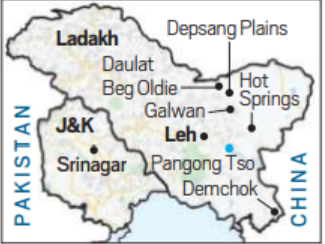
- Depsang Plains
- Located in eastern Ladakh, the Depsang Plains are strategically significant due to their proximity to the Karakoram Pass, connecting Ladakh with China’s Xinjiang region.
- Depsang has been a frequent point of contention due to its flat terrain, which allows for easy military movement.
- It was one of the major areas affected during the 2020 stand-off, and patrolling there has recently resumed.
- Demchok
- Situated in the southeastern part of Ladakh, Demchok is close to the LAC, with a population primarily consisting of nomadic herders.
- It has been a friction point with China since 2017, with tensions over infrastructure development and grazing rights.
- The recent disengagement agreement aims to return control to the pre-April 2020 status, though specific patrolling limits remain unclear.
- Galwan Valley
- This narrow valley lies near the confluence of the Galwan River and the Shyok River in Ladakh.
- The site witnessed a violent clash in June 2020, leading to casualties on both sides.
- Since then, buffer zones have been established here, and patrolling is yet to resume under new norms.
- Gogra and Hot Springs
- Gogra and Hot Springs are located northwest of Pangong Tso and are key areas along the LAC.
- Both areas saw significant troop build-ups and tensions during the 2020 stand-off.
- Disengagement agreements have created buffer zones, and resumption of patrolling here is under discussion.
- Pangong Tso (Lake)
- This high-altitude lake stretches from India to China, with roughly two-thirds of it under Chinese control.
- Line of Actual Control (LAC)
- The LAC serves as the de facto border between India and China, running through Ladakh in the western sector.
- Patrolling along the LAC has been a source of frequent tensions, with disputed areas and differing perceptions of the boundary on both sides.
- Limit of Patrolling (LoP)
- The LoP refers to the farthest points up to which Indian troops traditionally patrol, marking India’s perception of the LAC.
- In Depsang, the LoP is notably distant from the LAC itself, underscoring the vast, disputed area and strategic concerns around patrolling rights.
3. China’s space station crew returns to earth after six months
(Source – The Hindu, International Edition – Page No. – 15)
| Context |
|
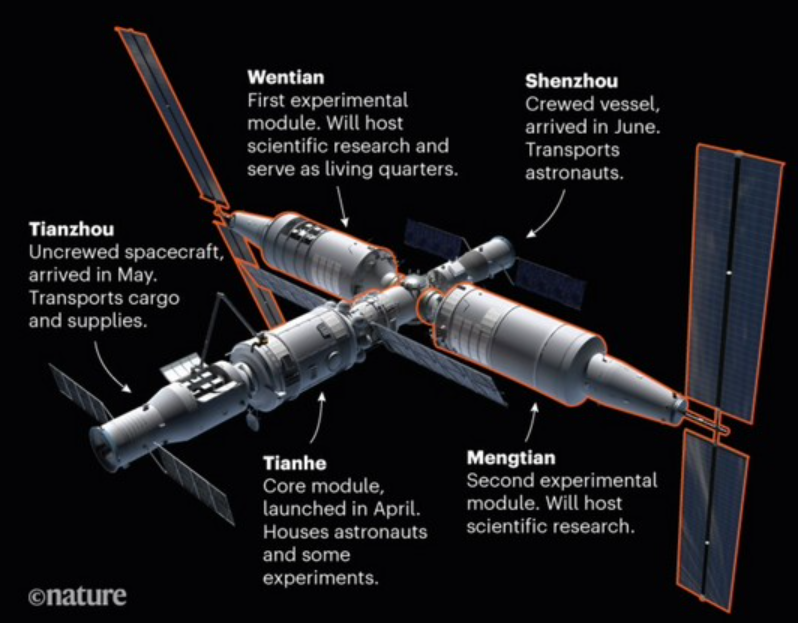
Tiangong Space Station
- Tiangong, meaning “Heavenly Palace,” is China’s modular space station, completed in 2021.
- It orbits Earth at an altitude of approximately 340 to 450 kilometers.
- The station supports various scientific experiments and international collaborations in fields such as astronomy, biology, and materials science.
- Tiangong has hosted multiple crewed missions and is expected to be operational for over a decade.
- It plays a crucial role in China’s goal to become a leading player in global space exploration.
Long March-2F Carrier Rocket
- The Long March-2F is a Chinese expendable launch vehicle primarily used for crewed missions to the Tiangong space station.
- It is capable of carrying payloads of up to 8.5 tons into low Earth orbit.
- The rocket features a two-stage design, with a strong emphasis on reliability and safety for human spaceflight.
- Its maiden flight occurred in 1999, and it has since successfully launched numerous missions, including Shenzhou crewed spacecraft.
- The Long March-2F is integral to China’s expanding space capabilities and exploration ambitions.





